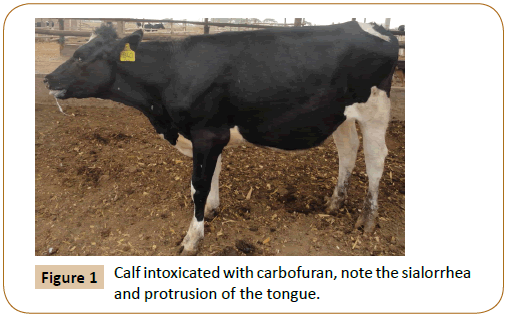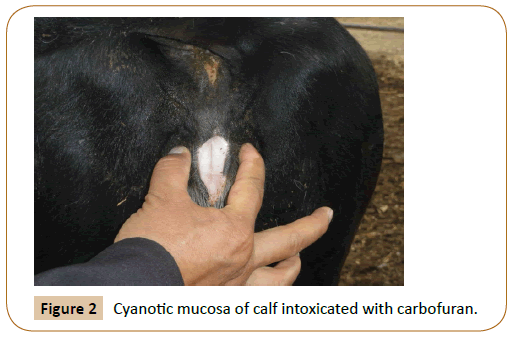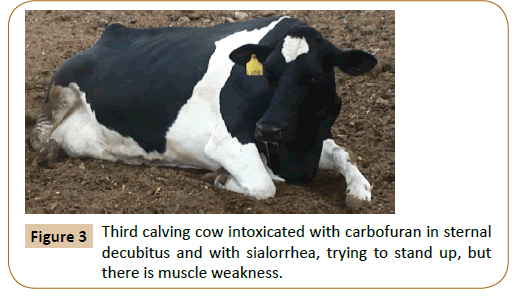Keywords
Intoxication; Carbofuran; Cattle; Peru
Introduction
Carbofuran is a carbamate pesticide with systemic and contact action [1], which is used as an insecticide or antiparasitic agent in the farming system [2] and according to the Organization's toxicological classification of pesticides. World Health is included in Category Ib: "Highly dangerous product") [3]. The risks of poisoning by carbamates and especially by carbofuran in animals are becoming more frequent [4-7], this Due mainly to its accidental inclusion in food or overdose [4,5], it should be noted that its maximum toxicity is achieved by inhalation and ingestion of the product, its dermal absorption being moderately toxic [8].
The mechanism of action of the carbamates is based on the reversible competitive inhibition of the enzyme acetylcholinesterase (AChEase), present in the central and peripheral nervous system [9]. With the inhibition of AChEase there is a progressive accumulation of acetylcholine (ACh) in nerve synapses [1], which can´t be split into choline and acetate, as is normally the case [9] triggering a series of clinical manifestations.
The acute clinical manifestations will depend on the stimulation of the receptors for ACh, which are of two types: nicotinic and muscarinic. Due to the muscarinic effect: in the gastrointestinal system there is an increase in salivation, defecation and gastroenteritis. At ocular level, the most frequently observed effect is miosis. On the heart the inhibitory effects of acetylcholine on the SA node cause bradycardia. In the respiratory system, the stimulation of the glands of the bronchial tree produces a large amount of secretion that can obstruct the airways. On the other hand, due to the nicotinic effect: tremors and muscle weakness occur at the neuromuscular level; it is also possible that paresis or total paralysis occurs after the acute cholinergic crisis [10]. Because carbamates do not cross the blood-brain barrier with ease, central nervous system signs are limited [6].
The main cause of morbidity and mortality in carbamates acute poisoning is respiratory failure caused by pulmonary edema. This has been demonstrated in humans, in cattle and in experimental [11].
Clinical Case
In February 2018, several clinical signs compatible with a case of acute intoxication were presented in a stable in the Peruvian province of Canete. The owner at the time of the consultation reported that the animals presented depression, excessive salivation and a wobbly gait.
The affected animals were a total of 18, of which 17 were Holstein calves of 6 months of age and 1 Holstein cow of third calving. After the anamnesis, it was determined that the calves had received a topical treatment for mange one day before, composed of sulfur, burned oil and a product based on carbofuran. In addition, the product based on carbofuran had been mixed with corn and spread on the floor of the pens to control pigeons present in the barn, which was a common practice of the owner.
During the clinical examination of the affected animals, depression, sialorrhea, dyspnea, miosis, muscle tremor, motor incoordination and prostration were found. In calves, clinical signs appeared within 24 hours after topical application, but the cow of third calving presented clinical signs after one week of the event in calves. Of the 17 calves, 1 of them died a few hours after presenting some clinical signs, for which a necropsy was performed, where samples of liver and intestine were collected. Also samples food was collected of warehouse. These duly refrigerated samples were taken to the Center for Information, Toxicological Control and Support for Environmental Management-CICOTOX, of the Faculty of Pharmacy and Biochemistry of the National University Major of San Marcos for toxicological analysis according to the method of thin layer chromatography. The result was positive to carbamate in all samples.
Affected animals were treated with 1% atropine sulfate in a 0.50 mg/kg dose intravenously and with support fluid therapy. Ten minutes after the treatment, the generalized improvement of the animals was observed. Only one calf needed one more dose of atropine sulfate 1%, at 6-hour interval, to recover (Figures 1-3).

Figure 1: Calf intoxicated with carbofuran, note the sialorrhea and protrusion of the tongue.

Figure 2: Cyanotic mucosa of calf intoxicated with carbofuran.

Figure 3: Third calving cow intoxicated with carbofuran in sternal decubitus and with sialorrhea, trying to stand up, but there is muscle weakness.
Discussion
Based on the clinical history, exposure to the toxic and the compatible clinical sign, acute intoxication by carbofuran was suspected. As mentioned earlier, carbofuran is the carbamate that is most frequently involved in accidental poisonings [4]. In the present case, the use of carbofuran as a topical treatment for scabies could have been the source of the poisoning. Another important factor, which possibly contributed to the increase in toxic absorption through the skin, was the use of burned oil, since the burned oil irritates the skin and causes erosions. Because large quantities of carbofuran are not needed to exert its toxic action, since its LD50 varies between 3-19 mg / kg p.v. for most species [12]; carbofuran was highly toxic in calves.
However, diagnostic confirmation was achieved using the thinlayer chromatography method in samples of liver, intestine and food. The determination of the toxic in the food, confirms the idea that food poisoning could also exist, especially in the cow of third parturition, in which no treatment was applied for the control of scabies.
As it is known, carbamates react with the AChEase enzyme in a manner similar to ACh, that is, they competitively inhibit cholinesterase activity [9] behaving as anticholinesterase substances. The AChEase enzyme is responsible for the destruction and termination of the biological activity of the ACh neurotransmitter; since the AChEase is inhibited ACh accumulates in the synaptic space altering the normal functioning of the nerve impulse [1]. The accumulation of ACh occurs in cholinergic neuroeffector junctions (muscarinic effects), in the myoneural junctions of the skeleton and autonomic ganglia (nicotinic effects) as well as in the central nervous system [10].
This anticholinesterase effect was corroborated by observing the different clinical signs in all affected animals, such as miosis, motor incoordination, sialorrhea, muscular tremor and prostration. Only in one animal, death was continued, due to the rapidity of clinical signs due to severe intoxication.
Based on the clinical signs, a treatment with 1% atropine sulfate was implanted that inhibits the effects produced by ACh in the muscarinic receptors. It should be noted that atropine sulfate does not neutralize the AChEase-carbamil binding but blocks the effect of ACh on the muscarinic nerve terminals. In this way, atropine sulfate prevents muscarinic effects, but not nicotinic effects, which cause motor incoordination and muscle tremors [13]. A high dose of atropine sulfate (0.5 mg/kg) was used to accelerate the response to treatment, which in turn helped in the confirmation of the diagnosis. However, it was not effective to avoid the death of 1 calf due to severe exposure.
Intoxication by carbamates and organosphosphorates in production animals are among the main causes of poisonings [14]. Therefore, the importance in exposing such cases; since inadvertent manipulation by unqualified personnel can be fatal.
References
- Castillo A, Rojas J, Monteros S, Ramiro l, Nardelli J (2003) Métodos para determinar carbofuran (2,3-dihidro-2,2-dimetilbenzofuran-7-IL metilcarbamato). Agrotecnia 10: 15-20.
- Barros C, Driemeier D, Dutra I, Lemos A (2006) Organophosphate poisoning in cattle in Rio Grande do Sul. Braz Vet Res 10: 130-133.
- World Health Organization (2009) The WHO recommended classification of pesticides by hazard and guidelines to classification. Available from: https://www.who.int/ipcs/publications/pesticides_hazard/en/
- Novtoný L, Misík L, Honzlová A, Ondracek P, Kuca K, et al. (2011) Incidental poisoning of animals by carbamates in the Czek Republic. J Appl Biomed 9: 157-161.
- Zeinsteger P, Oliver C, Ledri D, Danielle M, Mestorino N (2014) Presence of Pesticide Carbofuran (Carbamato) in Bait Samples and Gastric Content of Caninos of The City of Urdinarrain, Entre Ríos.
- Ferré D, Saldeña E, Albarracín L, Neuilly V, Gorla N (2015) Inhibition of butyrylcholinesterase in two intoxicated dogs and analytical confirmation of carbofuran as the causative agent. Rev Vet 26: 43-48.
- Caloni F, Cortinovis C, Rivolta M, Davanzo F (2016) Suspected poisoning of domestic animals by pesticides. Sci Total Environ 539: 331-336.
- Karam M, Ramírez G, Bustamante P, Galván J (2004) Pesticides and population health. Ciencia Ergo Sum 11: 246-254.
- Gupta R (2006) Toxicology of organophosphate and carbamate compounds. Academic Press, Elsevier.
- Osweiller G, Hovda L, Lee J (2011) Small Animal Toxicology. Clinical Companion. Blackwell Publishing Ltd., United States, pp: 865-869.
- Ferslew K, Hagardorn A, McCormick W (1992) Poisoning from oral ingestion of carbofuran (Furadan 4F), a cholinesterase-inhibiting carbamate Insecticide, and its effects on cholinesterase activity in various biological fluids. J Forensic Sci 37: 337-44.
- Wang Y, Kruzik P, Helsberg A, Heslberg I, Rausch W (2007) Pesticide poisoning in domestic animals and livestock in Austria: a 6 years retrospective study. Forensic Sci Int 169: 157-160.
- Ecobichon D (1995) Toxic effects of pesticides. J Casarett and doull´s toxicology: the basic science of poisons. McGraw Hill, New York, USA, pp: 643-690.
- Radostits O, Gay C, Hinchcliff K, Constable P (2007) Organopbhosphorous compunds and carbamates (organophosphates). In: Ibid I (ed.), Veterinary Medicine. WB Saunders, United States of America.




